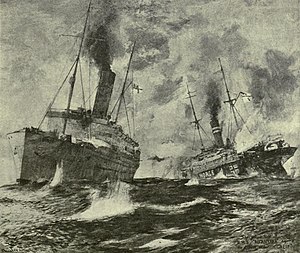SMS Greif (1914)
 HMS Alcantara (left) and SMS Greif (right) dueling at close range during the action of 29 February 1916.
| |
| History | |
|---|---|
| Name | Greif |
| Builder | Neptun Werft, Rostock[1] |
| Launched | 1914[1] |
| Acquired | 1915[1] |
| Commissioned | 23 January 1916[1] |
| Fate | Sunk 29 February 1916 |
| General characteristics | |
| Displacement | 9,900 tons normal[1] |
| Length | 131.7 m (432 ft)[1] |
| Beam | 16.4 m (54 ft)[1] |
| Draught | 7.5 m (25 ft)[1] |
| Propulsion | Two coal-fired boilers, one 3,000 shaft horsepower (12 MW) 3-cylinder triple expansion reciprocating steam engine driving one propeller[1] |
| Speed | 13 knots (24.1 km/h)[1] |
| Range | 35,000 nautical miles (65,000 km) at 10 knots (19 km/h)[1] |
| Complement | 10 officers & 297 men[2] |
| Armament | Four 15 cm (5.9 in) SK L/40 guns (4 × 1) with 600 rounds ammunition, one 10.5 cm (4.1 in) SK L/40 rapid-fire gun with 200 rounds ammunition, and two 50 cm (20 in) torpedo tubes with 12 torpedoes[3] |
SMS Greif was a German cargo steamship that was converted into a merchant raider for the Imperial German Navy.[1]
Construction and conversion
Built as Guben, she was a 4,962 GRT steel-hulled ship owned by the German-Australian Line (DADG), Hamburg.[1] She was converted for naval service at Kaiserliche Werft Kiel in 1915 and commissioned as Greif on 23 January 1916.[1]
Service history
Greif sailed from the Elbe port of Cuxhaven on 27 February 1916[4] under the command of Fregattenkapitän Rudolf Tietze (born 13 September 1874, previously was commander of the battleship SMS Wörth).[5] The Royal Navy had learned of Greif's sailing and was waiting in the North Sea.[6]
Action of 29 February 1916
Greif was disguised as the
Alcantara was hit by a torpedo amidships on her port side, and one of Alcantara's shells exploded the ready ammunition for Greif's after gun.[4] Both ships lost speed.[4] Greif's crew abandoned ship 40 minutes after opening fire.[4] Alcantara sank first.[4] The C-class light cruiser Comus and M-class destroyer Munster then arrived to sink the stationary Greif[4] and rescue 120 German survivors.[2] An estimated 187 Germans perished along with 72 Britons.
Notes
References
- Poole, Francis (July 1975). "Alcantara vs. Greif: Duel of the Merchant Cruisers". United States Naval Institute Proceedings.
{{cite journal}}: Cite journal requires|journal=(help) - Schmalenbach, Paul (1977). German Raiders. Annapolis, MD: ISBN 0-85059-351-4.
External links
 Media related to Greif (ship, 1915) at Wikimedia Commons
Media related to Greif (ship, 1915) at Wikimedia Commons
